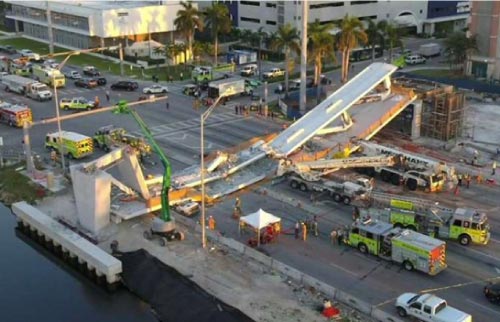It’s been a year and a half since a pedestrian bridge collapsed at Florida International University in March of 2018, killing six people. Recently, OSHA came out with a 115-page report concluding that the tragedy could very well have been prevented.
Just hours before the bridge collapsed, its design engineers inspected the deep structural cracks and asserted that they posed no safety concerns. The bridge’s contractor, who was also made aware of safety concerns by its employees on the morning of the collapse, also failed to alert authorities and close the street below the weakening bridge.
Now, not only is the engineering firm being implicated, but also the construction management company that built the bridge. Ultimately, where does the fault lie and how could this have been prevented?
Those who study structural health monitoring know one thing, a structure’s integrity begins way before construction starts. It begins in the design phase. Before starting a design, the structural engineer must determine the criteria for acceptable performance, including the loads or forces to be resisted.
Types of analysis include equilibrium, stress, strain, and elasticity. Once the correct types of tests for that structure have been identified , final design can proceed. Deflections and allowable stresses or ultimate strength must be checked against criteria provided either by the owner or by the governing building codes.
That’s when safety at working loads is calculated. Several methods are available, depending on the types of materials used. One method is the Finite Element Model (FEM) or Finite Element Analysis (FEA).
FEA is the process of using mathematical models to simulate displacement, stresses, strains, and other parameters to predict the performance and limits of a design. FEA models rely on statistical assumptions to determine how a design will behave in a real-world environment, but reality often does not match the scenario assumed by models.
Reasons could include tiny cracks in the material, retrofitting situations, and/or unexpected environmental impacts. This design analysis phase is where the engineering firm that designed the FIU Pedestrian Bridge fell short. In fact, the OSHA report concluded that the cracks were “due to deficient structural design.”
The engineers probably performed the necessary tests on their model using traditional resistive strain gauges. They could and should have used distributed sensing technology to validate the efficacy of their design.
Unlike traditional strain gauges which report information at critical points in the structure, distributed fiber optic sensing obtains data along the entire length of the structure. In addition to collecting data at the critical points, it measures between these points.
This provides an unprecedented level of insight into the behavior of a structure and allows engineers to perform comprehensive model validation at thousands of discrete points, instead of just a few, identifying just about any source of weakness long before the structure is constructed.
In addition, once construction of the bridge was complete, the managing contractor should have immediately checked the bridge’s structural health and instituted an ongoing plan to monitor structural health.
Once again, the engineers probably used individual resistive strain gauges placed at various critical points along the span of the bridge to test its structural integrity. However, with this discrete point solution for checking, how could they really be sure that the entire length of the bridge was structurally sound?
Again, distributed strain sensing for structural health monitoring and safety is key. Forward and safety thinking engineers perform continuous real-time monitoring of critical structures on an ongoing basis.
Mechanical strain, stress, loads, temperature, and deflection are just a few of the various engineering parameters that they continue to test and monitor. With distributed strain sensing, a hair-like optical fiber with spatial resolution down to 1.6mm, leaves almost no point undetected .
Multiple fibers can be deployed across a structure to create an effectively weightless network of sensors, capable of continuous structural health monitoring at several thousand locations – thus protecting critical assets and lives.
According to the Miami Herald, the OSHA report confirms what independent experts who examined the bridge design plans and engineering calculations hypothesized that “the collapse was triggered by sending work crews to re-tension internal support cables at the critical structural connection where the cracks appeared.”
What if they were aware of the exact portion of the bridge that held the most critical weakness – not just where the cracks appeared?
They might have made changes in the structural design of the bridge, they certainly would have built the bridge differently, and with structural health monitoring they would have had advance notice of critical weaknesses forming and would have been able to take necessary safety steps to avoid the six deaths that resulted that day.
For more information, visit our Resources page.

